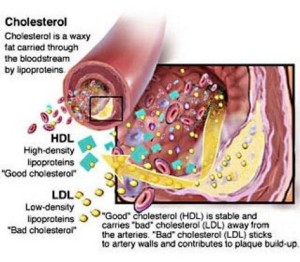 Skipping a few meals may reduce the risk of developing diabetes via a newly identified biological process that converts bad cholesterol in fat cells into energy. Researchers from the Intermountain Medical Center in Murray, Utah, observed that after 10 to 12 hours of fasting the body begins to scavenge for other sources of energy to sustain itself. In their new paper the researchers describe how the fasting body extracts LDL cholesterol from fat cells to metabolize into energy.
Skipping a few meals may reduce the risk of developing diabetes via a newly identified biological process that converts bad cholesterol in fat cells into energy. Researchers from the Intermountain Medical Center in Murray, Utah, observed that after 10 to 12 hours of fasting the body begins to scavenge for other sources of energy to sustain itself. In their new paper the researchers describe how the fasting body extracts LDL cholesterol from fat cells to metabolize into energy.
“Fasting has the potential to become an important diabetes intervention,” says Benjamin Horne, PhD, lead researcher on the study. “Though we’ve studied fasting and it’s health benefits for years, we didn’t know why fasting could provide the health benefits we observed related to the risk of diabetes.”
Earlier research done by Dr. Horne and his team focused on healthy people during one day of fasting, revealing that short-term, water-only fasting was linked to reduced glucose levels and weight loss.
“When we studied the effects of fasting in apparently healthy people, cholesterol levels increased during the one-time 24-hour fast,” said Dr. Horne. “The changes that were most interesting or unexpected were all related to metabolic health and diabetes risk. Together with our prior studies that showed decades of routine fasting was associated with a lower risk of diabetes and coronary artery disease, this led us to think that fasting is most impactful for reducing the risk of diabetes and related metabolic problems.”
Due to the findings in 2011, Dr. Horne launched this new study to look at the effects of fasting in prediabetics over an extended period of time (prediabetes indicates that glucose, or blood sugar levels, are higher than normal but not high enough to qualify as diabetes.) The study followed a group of prediabetics, including men and women between the ages of 30 and 69 presenting with at least three metabolic risk factors. These risk factors include:
- A large waistline. This also is called abdominal obesity or “having an apple shape.”
- A high triglyceride level. Triglycerides are a type of fat found in the blood.
- A low HDL cholesterol level, the “good” cholesterol. A low HDL cholesterol level raises your risk for heart disease.
- High blood pressure. Blood pressure is the force of blood pushing against the walls of your arteries as your heart pumps blood.
- High fasting blood sugar. Mildly high blood sugar may be an early sign of diabetes.
Some participants in the new study were obese and some were not. In previous fasting research the focus was on weight loss in obese individuals due to fasting. Though weight loss did occur in the current study (three pounds over six weeks), the main focus was diabetes intervention.
“During actual fasting days, cholesterol went up slightly in this study, as it did in our prior study of healthy people, but over a six-week period cholesterol levels decreased by about 12 percent in addition to the weight loss,” said Dr. Horne. “Because we expect that the cholesterol was used for energy during the fasting episodes and likely came from fat cells, this leads us to believe fasting may be an effective diabetes intervention.”
The process of extracting LDL cholesterol from fat cells for energy should help reverse insulin resistance. Insulin resistance occurs when cells become less sensitive to the effects of insulin. This results in rising blood sugar levels (hyperglycemia) and a drop in energy production. To compensate for insulin resistance – and to keep blood glucose levels from spiraling out of control – the pancreas tries to restore balance by producing more insulin. Left unchecked, cells become even more resistant to insulin even as the pancreas secretes ever greater amounts in a desperate attempt to bring the system back under control. This results in dangerously high blood levels of insulin (hyperinsulinemia). If not corrected the pancreas eventually becomes exhausted, resulting in diabetes and requiring daily blood monitoring and injections of insulin to manage blood sugar levels.
“The fat cells themselves are a major contributor to insulin resistance, which can lead to diabetes,” he said. “Because fasting may help to eliminate and break down fat cells, insulin resistance may be frustrated by fasting.”
Dr. Horne says that more in-depth study is needed, but the findings lay the groundwork for that future study.
“Although fasting may protect against diabetes,” said Dr. Horne. “It’s important to keep in mind that these results were not instantaneous in the studies that we performed. It takes time. How long and how often people should fast for health benefits are additional questions we’re just beginning to examine.”
Source: Intermountain Medical Center. “Fasting reduces cholesterol levels in prediabetic people over extended period of time, new research finds.”












[…] “Fasting has the potential to become an important diabetes intervention,” says Benjamin Horne, PhD, lead researcher on the study. “Though we’ve studied fasting and it’s health benefits for years, we didn’t know why fasting could provide the health benefits we observed related to the risk of diabetes.” Read more… […]